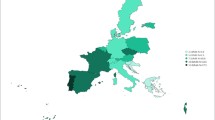Abstract
Background
The aim of the study was to determine which risk factors were associated with the recurrence of falls among community-dwelling older adults.
Methods
Based on a cross-sectional design, 1066 community-dwelling volunteers aged 65 and older were recruited. The use of psychoactive drugs, the number of drugs taken per day, the basic mobility assessed with the Timed Up & Go test (TUG), the maximal isometric voluntary contraction strength of hand, the lower limb proprioception, the distance binocular vision, the fear of falling and the history of falls during the past year were recorded. Subjects were separated into 4 groups based on the number of falls: 0, 1, 2 and > 2 falls.
Results
Among the 395 (37.1%) fallers, 291 (27.3%) were single fallers and 104 (9.8%) were recurrent fallers (i.e., > 2 falls). The numbers of falls increased significantly with age (Incident Rate Ratio (IRR)=1.03, p<0.001), female gender (IRR=1.95, p<0.001), institutionalization (IRR=1.66, p=0.002), number of drugs taken per day (IRR=1.05, p<0.001), use of psychoactive drugs (IRR=1.29, p=0.009), increased time of TUG Test (IRR=1.02, p<0.001), use of a walking aid (IRR=1.59, p=0.002), and fear of falling (IRR=3.08, p<0.001). In addition, a high score at the handgrip test (IRR=0.97, p<0.001) and distance binocular vision (IRR=0.92, p<0.001) were associated with a decreased number of falls. After adjustment for potential confounders, only female gender (IRR=1.44, p<0.001), vision (IRR=0.95, p=0.006) and lower limb proprioception (IRR=0.95, p=0.046), and fear of falling (IRR=2.68, p<0.001) were still significantly associated with the number of falls.
Conclusion
The current study shows that female gender, poor vision and lower limb proprioception, and fear of falling were associated with the recurrence of falls.
Similar content being viewed by others
References
Hauer K, Lamb SE, Jorstad EC, Todd C, Becker C; PROFANE-Group. Systematic review of definitions and methods of measuring falls in randomised controlled fall prevention trials. Age Ageing. 2006;35:5–10.
Rubenstein LZ. Falls in older people: epidemiology, risk factors and strategies for prevention. Age Ageing. 2006;35Suppl 2:ii37–ii41.
Tinetti M. Preventing falls in elderly persons. N Engl J Med 2003;348:42–49.
American Geriatrics Society, British Geriatrics Society, and American Academy of Orthopedic Surgeons panel on falls prevention. Guideline for the prevention of falls in older persons. J Am Geriatr Soc 2001;49: 664–772.
Nevitt MC, Cummings SR. Risk factors for injurious falls: a prospective study. J Gerontol 1991;46:M164–M170
Vellas BJ, Wayne SJ, Romero LJ, Baumgartner RN, Garry PJ.Fear of falling and restriction of mobility in elderly fallers. Age Ageing 1997;26:189–193
Gillespie L. Preventing falls in elderly people. BMJ 2004;328:653–654.
Bloem BR, Steijns JA, Smits-Engelsman BC. An update on falls. Curr Opin Neurol 2003;16:15–26.
Oliver D, Britton M, Seed P, Martin FC, Hopper AH. Development and evaluation of evidence based risk assessment tool (STRATIFY) to predict which elderly inpatients will fall: case-control and cohort studies. BMJ. 1997;315:1049–1053
Stel VS, Pluijm SM, Deeg DJ, Smit JH, Bouter LM, Lips P. A classification tree for predicting recurrent falling in community-dwelling older persons. J Am Geriatr Soc. 2003;51:1356–1364.
Lipsitz LA, Jonsson PV, Kelley MM, Koestner JS. Causes and correlates of recurrent falls in ambulatory frail elderly. J Gerontol. 1991;46:M114–M122.
Podsiadlo D, Richardson S. “The Timed Up & Go”: A test of basic functional mobility for frail elderly persons. J Am Geriatr Soc 1991;39:142–149.
Brodaty H, Pond D, Kemp NM, Luscombe G, Harding L, Berman K, Huppert FA. The GPCOG: a new screening test for dementia designed for general practice. J Am Geriatr Soc. 2002;50:530–534.
Lord SR, Ward JA, Williams P et al. Physiological factors associated with falls in older community-dwelling women. J Am Geriatr Soc 1994;42:1110–1117.
Scheffer AC, Schuurmans MJ, van Dijk N, van der Hooft T, de Rooij SE. Fear of falling: measurement strategy, prevalence, risk factors and consequences among older persons. Age Ageing. 2008;37:19–24.
Stata Statistical Software: Release 8.2 [program]. College Station, Texas, USA: Stata Corporation 2003.
Speechley M, Tinetti M: Falls and injuries in frail and vigorous community elderly persons. J Am Geriatr Soc 1991;39:46–52.
Fried LP, Bandeen-Roche K, Kasper JD, Guralnik JM. Association of comorbidity with disability in older women: the Women’s Health and Aging Study. J Clin Epidemiol 1999;52:27–37.
Moreland JD, Richardson JA, Goldsmith CH, Clase CM. Muscle weakness and falls in older adults: a systematic review and meta-analysis. J Am Geriatr Soc. 2004;52:1121–1129.
Hsiao ET, Robinovitch SN. Common protective movements govern unexpected falls from standing height. J Biomech 1998;31:1–9
Pai YC, Wening JD, Runtz EF, Pavol MJ. Role of feed forward control of movement stability in reducing slip-related balance loss and falls among older adults. J Neurophysiol 2003;90:755–762.
Covinsky KE, Kahana E, Kahana B, Kercher K, Schumacher JG, Justice AC. History and mobility exam index to identify community-dwelling elderly persons at risk of falling. J Gerontol A Biol Sci Med Sci 2001;56:M253–259.
Cummings SR, Nevitt MC, Kidd S. Forgetting falls. The limited accuracy of recall of falls in the elderly. J Am Geriatr Soc 1988;36:613–616.
Author information
Authors and Affiliations
Corresponding author
Rights and permissions
About this article
Cite this article
Rossat, A., Fantino, B., Nitenberg, C. et al. Risk factors for falling in community-dwelling older adults: Which of them are associated with the recurrence of falls?. J Nutr Health Aging 14, 787–791 (2010). https://doi.org/10.1007/s12603-010-0089-7
Received:
Accepted:
Published:
Issue Date:
DOI: https://doi.org/10.1007/s12603-010-0089-7



